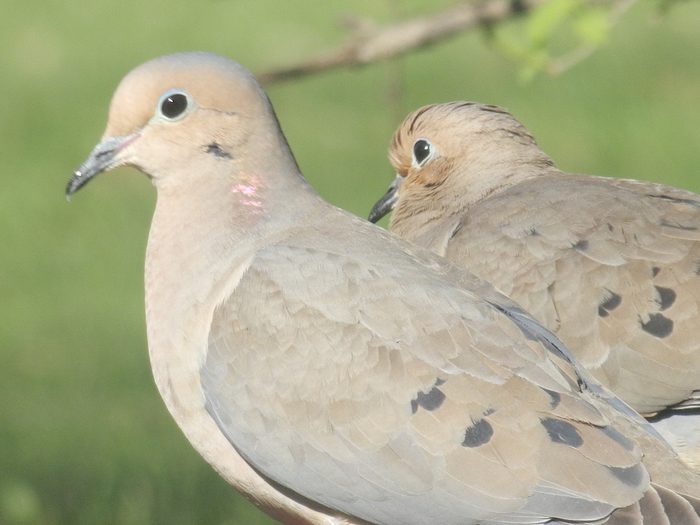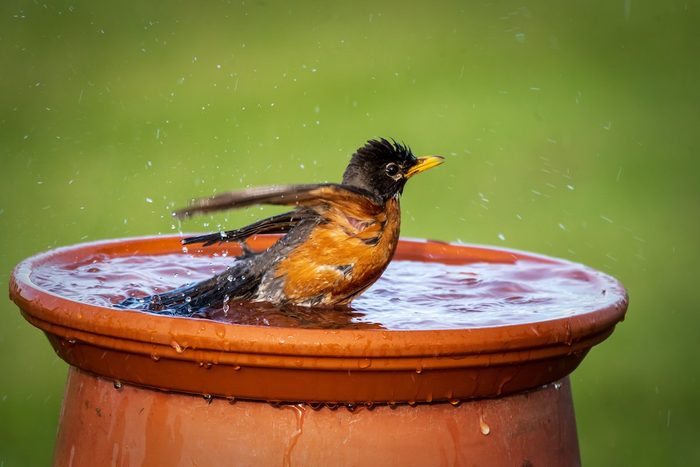It’s easy to see why conifers are a staple of most backyard landscapes. They provide reliable shelter for birds, offer nice color and year-round structure in the garden and are mostly maintenance-free. Now you can have those same virtues in a smaller package, thanks to newer downsized varieties. While often referred to as “dwarf conifers,” many of these are technically just slow growers.
They will eventually get larger in 20 or 30 years, but most stay fairly compact and are classified based on their growth rate and size at 10 years. With the help of conifer expert and author Richard L. Bitner (Timber Press Pocket Guide to Conifers), we put together this Top 10 list of dwarf conifers, specifically with small space gardening in mind.
On This Page
Norway Spruce
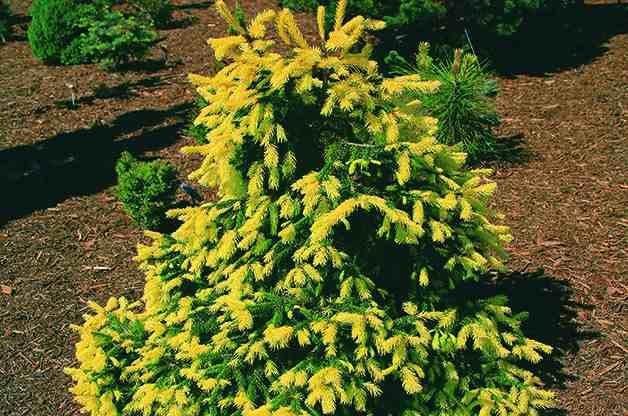
(Picea abies species, Zones 3 to 7)
This popular spruce has a pyramidal shape with shiny dark-green foliage. It prefers full sun, but adapts well to a variety of soil conditions and will tolerate wind. For years, it’s been a favorite fast-growing tree for large landscapes, but now gardeners are starting to look for dwarf cultivars as well. Some of the top choices include Clanbrassiliana, Echiniformis, Little Gem and Perry’s Gold (pictured).
Why we love it: The horticulture world has embraced this plant, so it’s easier to find than some other small conifers.
Check out the top 10 quick-growing shrubs.
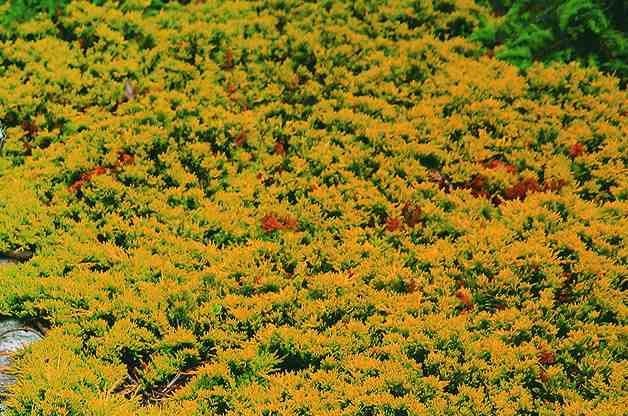
Creeping Juniper
(Juniperus horizontalis species, Zones 4 to 9)
This North American native grows well in just about any soil and is a popular choice for mountain slopes and seashores. Like other junipers, it prefers full sun and good drainage. Top picks include the blue-green Icee Blue, and Mother Lode (pictured), with its golden color in summer.
Why we love it: We’re always big fans of plants with dual benefits. With this one, you can have your conifer and ground cover, too!
Love evergreens? Discover the types of Christmas trees you can grow.
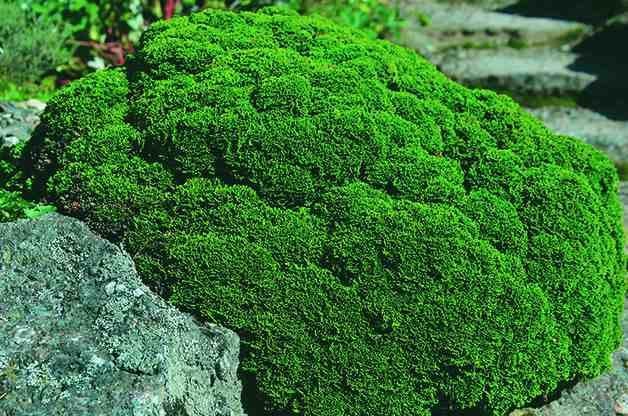
Hinoki False Cypress
(Chamaecyparis obtusa species, Zones 5 to 8)
If you need a conifer to provide unique form and texture, this is an excellent choice. A native of Japan, considered -sacred in the Shinto religion, it has dark-green fan- or shell-shaped foliage and interesting bark. For a small space, try slow-growing cultivars like Minima (pictured), the golden Nana Aurea and the glossy green Nana Gracilis.
Why we love it: This dwarf conifer is among the best of small conifers. Check a nursery or look online to find a cultivar that meets your needs.
Discover attractive drought-tolerant shrubs for your garden.
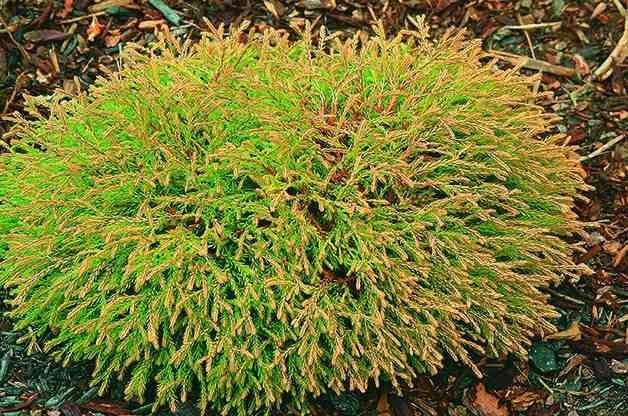
Arborvitae
(Thuja occidentalis, Zones 3 to 7)
This popular species is easy to find almost anywhere. But if you have deer in your area, beware. They love to munch on the foliage! The tree is dense, with a pyramidal shape and clusters of small seed-bearing cones. Smaller cultivars include Golden Globe, Hetz Midget and Tiny Tim.
Why we love it: It has a classic conifer look, provides generous coverage for birds and offers plenty of cultivars to choose from.
Problems with deer? Try these deer-resistant bulbs for spring blooms.
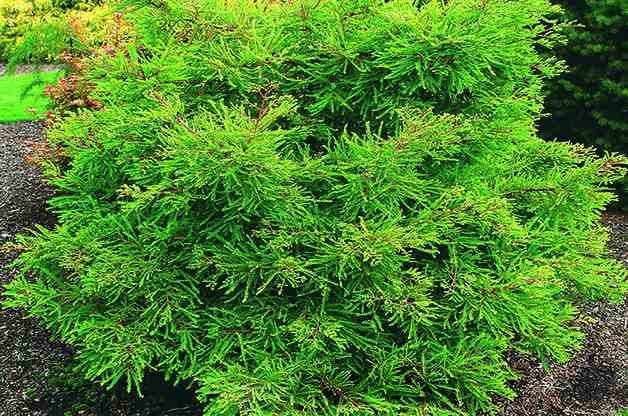
Bald Cypress
(Taxodium distichum, Zones 4 to 11)
Look for dwarf types of this deciduous tree that is found in the swamps of the eastern half of the U.S. (It’s also the state tree of Louisiana.) Bald cypress needs full sun and prefers moist, acidic, sandy soils. But what sets it apart is its availability to handle a variety of moisture conditions, even tolerating standing water. Slow-growing species include Cascade Falls, which is a compact weeping conifer. Also, Secrest is a nice flat-topped cultivar.
Why we love it: This tough conifer can handle wet and poorly drained sites. Also, it has beautiful orange to pumpkin-brown fall color before the needles drop.
Did you know you can use evergreen trees and shrubs to create winter shelter for birds?
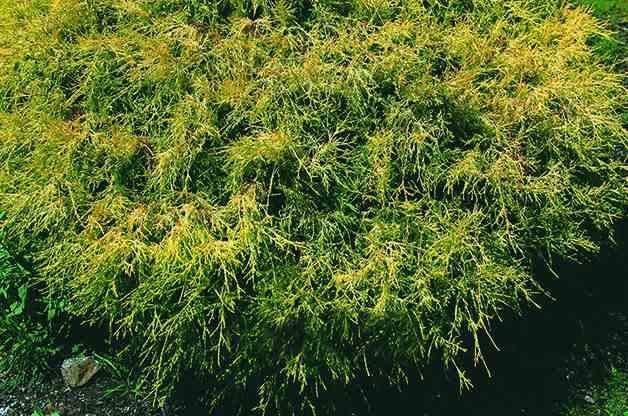
Sawara Cypress
(Chamaecyparis pisifera, Zones 4 to 8)
The cultivars of this species vary widely, with the large versions growing up to 150 feet in natural settings. Good cultivars for a small landscape include Filifera Aurea, with golden-yellow foliage that makes it an attractive border plant. Also try Golden Mop, a low and mounding variety with threadlike foliage.
Why we love it: If you do a little research, you can find dwarf varieties in all kinds of shapes and sizes, including shades of green, blue, yellow, white and variegated.
Psst—here are the things you need to know before planting a tree.
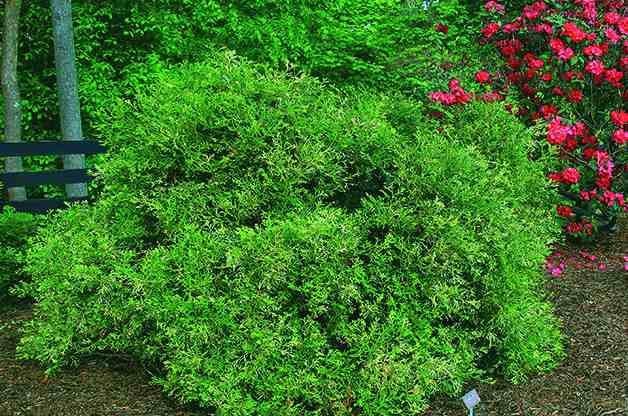
Hiba Arborvitae
(Thujopsis dolobrata species and cultivars, Zones 5 to 7)
A native of Japan, this conifer has large, broad branchlets with glossy leaves. It’s often used for hedging and is a versatile backyard plant. It’s not as common as other conifers, but it’s definitely worth a chance in your yard. Look for the compact form, Nana.
Why we love it: It tolerates a wide range of soils and does best in partial shade, making it a natural choice for many mature backyards.
Don’t miss the top 10 flowering shrubs that birds and butterflies love.
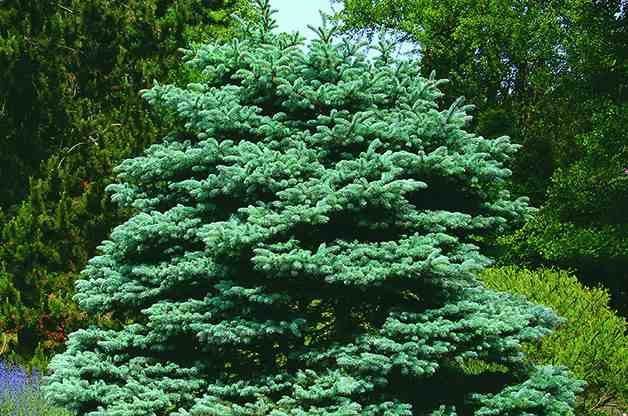
Dwarf Colorado Blue Spruce
(Picea pungens species, Zones 3 to 7, 8 to 9 on West Coast)
This Colorado native prefers rich, moist soils and full sun, though it is more drought-tolerant and adaptable than other spruces. Avoid insects, mites and diseases by finding a suitable location and providing proper care. Montgomery is a compact dwarf blue conifer that does well in most yards.
Why we love it: The stiff needles and elegant shape make it a standout in any yard. Check with your local extension office or nursery to find out what works well in your area.
Plant spruce trees to attract crossbills, the ultimate nomads of the bird world.
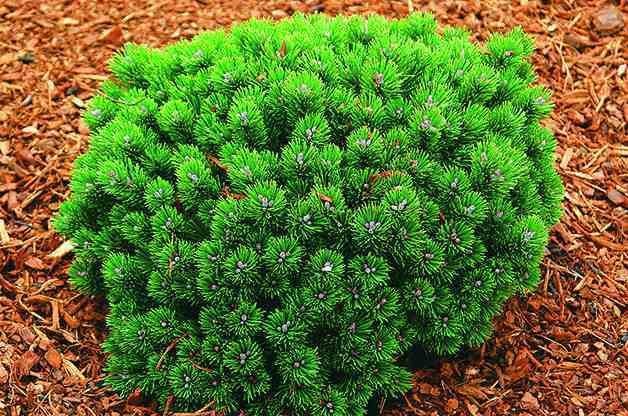
Mugo Pine
(Pinus mugo, Zones 2 to 7)
Dwarf mugo cultivars are most common but the species can grow 20 or even 30 feet tall. Mugos come in many varieties, including dwarf, upright and ground-hugging. Pine needle scale is common and can be a problem. Watch for disease problems in hot, humid summers. Top dwarf picks include Corley’s Mat, Sherwood Compact and Slowmound.
Why we love it: It’s one of the hardiest conifers available, thriving even in Zone 2! It also adapts well to many conditions and tolerates wind, drought and heat.
Learn about the top 10 tree diseases (and what to do about them).
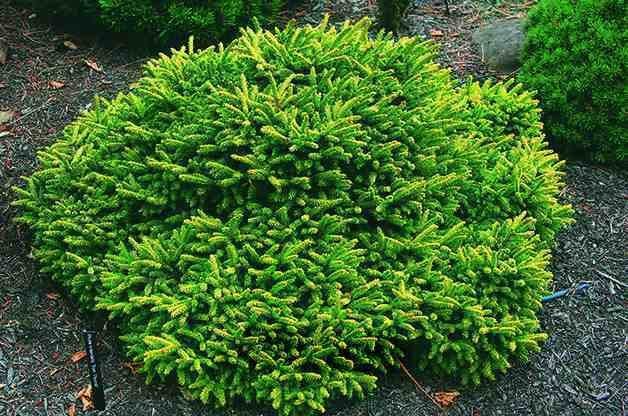
Oriental Spruce
(Picea orientalis species, Zones 4 to 7)
While Norway spruce is a favorite of many gardeners, the oriental spruce tends to be a better alternative. The needles are glossy green and soft to the touch. For smaller gardens, look for slow-growing cultivars like Nana (usually stays under 3 feet high), or Tom Thumb, with golden foliage.
Why we love it: It’s very tolerant! While you might have to protect it a bit during winter, it will tolerate some shade, drought and wind.
Love colorful fall foliage? Check out the best fall shrubs to grow.
1. What Do Silver-Spotted Skippers Look Like?
To identify these butterflies, it’s important to know their size and markings. Silver-spotted skippers have a wingspan of 1 3/4 to 2 1/4 inches. The upperside of the wings is dark brown with a long golden orange section toward the center. The hindwings have a prominent silver-white spot.
Need more help identifying butterflies? Here’s a cheat sheet.
2. Where to Find Silver-Spotted Skippers
The silver-spotted skipper is found in most of the continental U.S. and southern Canada near roadsides, gardens, fields and woodland edges.
3. How to Attract Silver-Spotted Skippers
Plant common milkweed, blazing star and thistles to attract more silver-spotted skippers to your garden. Check out these 16 long-blooming flowers for attracting butterflies and hummingbirds.
4. Where Do Silver-Spotted Skippers Lay Eggs?
Their host plants include black locust, false indigo, American wisteria and honey locust. Females lay single green (sometimes appearing white) eggs on or near the plants.
5. What Silver-Spotted Skipper Caterpillars Look Like
A yellow body and a brown-red head with bold eye spots help skipper caterpillars stand out. To attract more butterflies to your backyard, plant at caterpillar cafe in your garden.
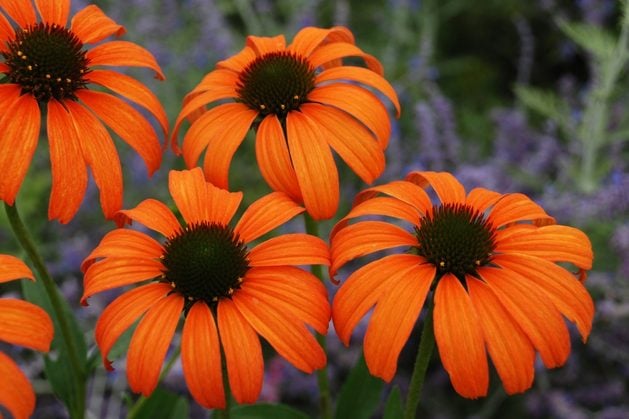
I’m a huge supporter of local nurseries and garden centers. I also like to support my area garden groups and plant sales. But as any plant geek knows, you can’t get all of your needs met in one place. People often ask me for recommendations on where to order plants online. It’s helpful for gardeners to know about the best online plant retailers. I pulled together my list of companies that I’ve personally ordered plants from, so I can definitely vouch for them. I like them for all different reasons, and I hope they help meet some of your needs as well. Because if there’s one thing every gardener needs, it’s more plants!
Great Garden Plants
Most of their plants are in big pots, and they are very healthy. They have many plant options available, but they are especially fantastic for unique coneflower varieties. Also check out the 7 best sources for buying flower bulbs online.
Bluestone Perennials
I started the garden in the front of my house with one of Bluestone Perennial’s pre-planned gardens. Don’t be afraid to try one of these kits. They are awesome, focusing on plants that are easy and low-maintenance. Then you can fill in as needed. Psst—check out 10 easy-to-grow houseplants all plant parents need.
Annie’s Annuals
They have great selection of annual plants. I once bought my mother-in-law some unique sunflowers from Annie’s. (It’s not always easy to find plants instead of seeds.) They have some really cool varieties. Check out the plants and gardening supplies we can’t stop buying on Amazon.
Logee’s
They specialize in fruiting, rare, and tropical plants. I bought my mom a lemon tree from Logee’s one year, and I have my eye on an avocado next. Check them out for unique options when you want to order plants online. Learn how to overwinter tropical plants.
Burpee
They are still one of my go-to sources for ordering veggie plants and seeds online. If you’re looking for something specific for your vegetable garden, they probably have it. If you’re new at vegetable gardening, try the top 10 easy-to-grow vegetables.
Breck’s
Breck’s is well known as a retailer of bulbs, from daffodils to dahlias, but also check out their large selection of perennials and shrubs.
Butterfly Bushes
They have the best selection of butterfly bushes that I’ve ever seen, and they offer many great varieties of flowering shrubs like viburnum and dogwood. Learn how to care for and prune butterfly bush.
Terroir Seeds (Underwood Gardens)
The couple that own Terroir Seeds are just delightful. We featured them a couple of years ago because they were one of the only places we could find that carried cucamelon seeds. Cucamelons are these adorable little veggie/fruits like a cross between a cucumber and a tiny little watermelon.
Next, shop for the canning supplies you need to preserve your favorite fruits and veggies.
You often hear about rare birds. People who are involved in conservation spend a lot of time thinking about them, and that’s certainly true for the two of us. We’re big advocates for whooping cranes, with only about 400 left in the world. Another species we often talk about is the Kirtland’s warbler, which was down to about 300 just a few years ago.
Rare birds tend to be rare for a reason. The Kirtland’s, for example, has a highly specialized habitat. It will raise its young only in large groves of short, young jack pine trees growing on sandy soil in just a few parts of Michigan and nearby areas.
While such rare species certainly deserve attention and care, what about their opposites? You know—those birds that seem to be everywhere!
Often these common birds are successful because they’re generalists. Unlike the Kirtland’s warbler, they don’t have specialized habitats—they can make do just about anywhere. Here’s a look at these easygoing birds of North America and the qualities that make them so abundant. Check out 15 backyard birds you should know.

Red-Winged Blackbird
Male red-wings, flashing their scarlet shoulder patches, are a familiar sight all over North America. While some marsh birds have become rare, red-wings don’t need pristine marshes. They’ll adapt to any pond edge, weedy ditch or even brushy field. There are probably some red-wings nesting in just about every county in the Lower 48 states, with a population estimated at 130 million to 190 million. Check out 7 surprising facts about red-winged blackbirds.
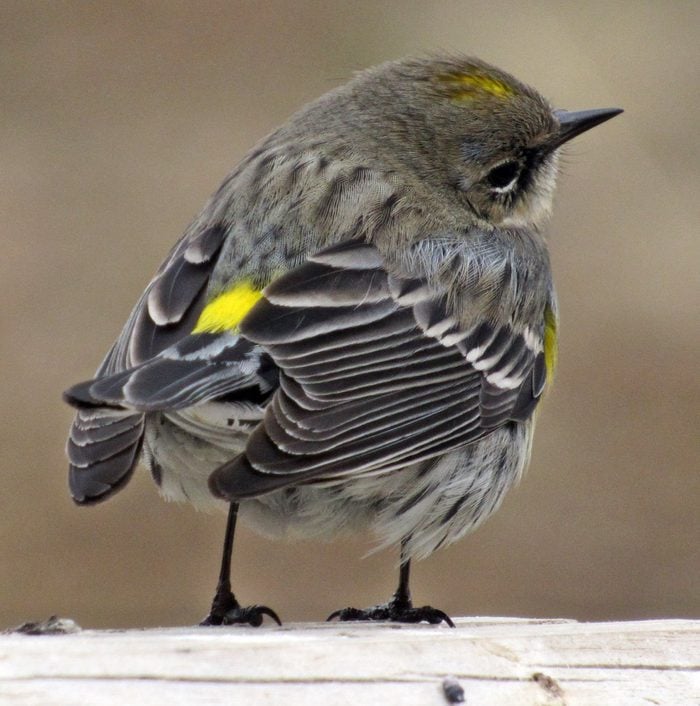
Yellow-Rumped Warbler
Tiny, colorful warblers are often hard to see as they flit from treetop to treetop, but they can swarm through the woods in great numbers during spring and fall migration. North America boasts more than 50 species of warblers; this one is probably the most abundant. It comes in two varieties, with the white-throated “Myrtle” type nesting from New England to Alaska and the yellow-throated “Audubon’s” all over the forests and mountains of the West. More adaptable than most warblers, these yellow-rumps eat berries as well as insects, so they can survive cold weather without migrating to the tropics. Their total population may be as high as 130 million. Discover 25 warblers you should add to your life list.
Mourning Dove
Adapted to a variety of open habitats, these doves also raise a lot of youngsters—as many as six broods a year in warmer climates. So even though they ordinarily lay only two eggs per clutch, a pair can produce up to a dozen offspring every year. Estimates of their population range as low as 100 million and as high as 475 million. Check out 15 breathtaking photos of mourning doves.

Dark-Eyed Junco
If you see lots of juncos around your feeders in winter, you’re not alone. These little snowbirds are thought to be among the most numerous North American species, with estimates of 150 million, 200 million or even more. Although they nest only in the North Woods and the mountains, they’re among the most common summer birds all across the vast forested regions of Canada, Alaska and the Northern states. Learn how to attract more juncos to your backyard.
American Robin
Originally they inhabited forests and swamps, but robins quickly learned to live around towns and cities when settlers began clearing the land. Today robins are abundant in towns, city parks, farms and forests. They nest all across Canada and Alaska, and in most parts of the Lower 48 states, except for the hottest Southern regions. Their total population has been estimated at 300 million. Here’s how to attract robins to your yard or garden.

European Starling
Brought to this continent around 1890 and released in Central Park, starlings have been wildly successful. Their total numbers here are above 50 million; some estimate that they may top 200 million. Starlings are smart, adaptable and tough, so their success isn’t surprising. Unfortunately, they’ve thrived at the expense of some native birds, taking over nesting sites from woodpeckers, bluebirds and others. Learn how to deal with bully birds at your feeders.

Mallard
We know more about duck numbers than we do about populations of most birds, because wildlife agencies keep careful counts of them every year. We know, for instance, that the North American mallard population in 2014 is around 11 million—higher than the long-term average, which is just under 8 million. Of course, that total number is much lower than the estimates for some of the songbirds. But ducks are big birds, and a million mallards take up a lot more room than a million robins. Check out 7 types of ducks to look for.

Chipping Sparrow
When European settlers began building towns and cities in eastern North America, tiny, tame chipping sparrows were among the first native birds to move in. They might have become the reigning city sparrows of this continent if house sparrows hadn’t been introduced from Europe; the bigger, more aggressive house sparrows took over the more populous areas. But chipping sparrows are still extremely common in suburbs, farms and open woods, with some experts putting their population at more than 200 million. Learn how to identify chipping sparrows.
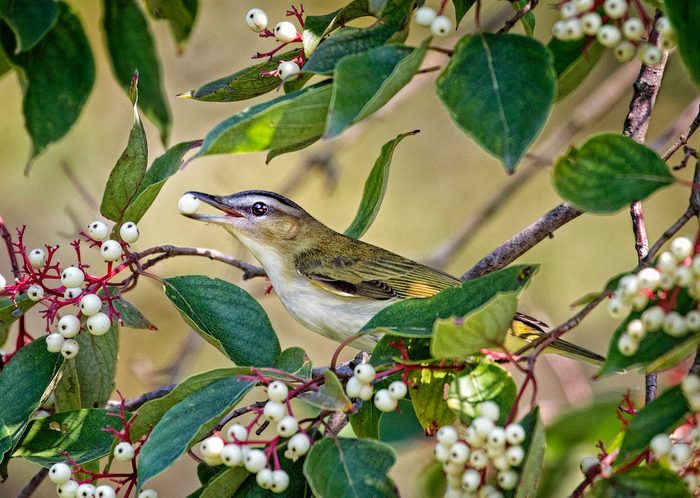
Red-Eyed Vireo
Bird-watchers are often surprised to learn that these vireos are among the continent’s most common birds. Moving slowly among the dense foliage of treetops, they’re very hard to see. But as soon as you learn to recognize their voice, you’ll discover that they’re indeed abundant. Their numbers may be overestimated because they’re such tireless singers, continuing to deliver their short, melodic phrases through the hot summer when many other birds have fallen silent. Even so, their population is probably over 80 million and perhaps more than 130 million. Check out the top songbirds in America.

Swainson’s Thush
Stand outside on a clear night in spring or fall, and you may hear the soft, musical notes of these thrushes high overhead, migrating in the dark. These shy brown birds are thought to be among the continent’s most abundant, with estimates as high as 100 million. The key to their success is their vast breeding range, throughout the boreal forests of Canada and Alaska, as well as the Northeastern states and all the higher mountains of the West.
Are Estimates Correct?
The numbers cited by experts on bird populations vary greatly. Mourning doves, for instance, are thought to number between a low of 100 million and a high of 475 million—almost five times the lowest estimate—but no one can be sure. Even the most highly trained ornithologists and conservationists can only make educated guesses.
3 Ways to Help Count Birds
By taking part in any of these projects, you’ll help provide data that scientists can use to track bird population trends.
1. Christmas Bird Count. This annual winter census by the National Audubon Society has gone on every year since 1900. Even if you’re a new birder, you can take part in the count by teaming up with experienced observers between Dec. 14 and Jan. 5. To find a local count, see birds.audubon.org.
2. Project FeederWatch. From early November through about the end of March, volunteers do regular counts at backyard feeders, turning in the results to the Cornell Lab of Ornithology. You’ll find more info at feederwatch.org.
3. Great Backyard Bird Count. A cooperative project of Audubon and Cornell, this count takes place over four days in February. Despite the name, it isn’t limited to backyards; you can count birds anywhere and submit the results. Visit gbbc.birdcount.org to learn more.
Unless you live on the water, you probably don’t see a lot of egrets and herons in your backyard. These are mostly wetlands birds, made for foraging in the shallows with their long leg legs and extended necks. Herons and egrets all belong to the same family (Ardiedae), which has 64 members worldwide.
In the U.S. and Canada, there are 10 heron and egret species you’re likely to find, with more found in the south. These are nearly all water birds, so look for them at the beach, along the river’s edge, and in marshy wetlands. Many of them group together to form breeding colonies, where their awkward nestlings are great fun to watch. No matter where you find egrets and herons, these large graceful birds always inspire a sense of awe.

On This Page
Great Blue Heron
Ardea herodias
Size: 38 – 54 inches tall, wingspan 65 – 80 inches
Great blue herons are one of the largest and most widespread wading birds in North America, found in wetlands throughout the region. They’re common in freshwater and saltwater, where they stalk the shallow shorelines for fish and crustaceans. Bluish-gray in color, these herons often stand motionless until they spot prey, when they move with lightning quick speed. Great blue herons are also one of the top 9 most beautiful birds in America.
Fascinating Fact: An all-white subspecies of the great blue heron lives in the Florida Keys.

Little Blue Heron
Egretta caerulea
Size: 22 – 30 inches tall, wingspan 39 – 41 inches
Little blue herons aren’t as widespread as great blue herons, mainly being found along the eastern and gulf coastlines and the wetlands of the Southeast. They spread north along the Mississippi to breed each summer. Little blue herons forage slowly in the shallows of marshes and estuaries. They are entirely blue, with a darker blue-purple head and a two-toned bill.
Fascinating Fact: Juvenile little blue herons are completely white. They gradually grow their blue feathers over their first year, resulting in a mottled blue and white pattern during this time.
Take our quiz and see how many shorebirds you can identify.

Great Egret
Ardea alba
Size: 37 – 41 inches tall, wingspan 51 – 57 inches
Slightly smaller and more sleek than great blue herons, great egrets are perhaps one of the most elegant birds of North America. Their pure white feathers are set off by shiny black legs and a long slender yellow bill. Look for them in wetlands across the country during fall and spring migration and summer breeding, and along the southern and western coasts in winter.
Fascinating Fact: In breeding season, great egrets grow spectacular feathery plumes around their tail end. They spread these feathers like a peacock and bob up and down to attract a mate.

Snowy Egret
Egretta thula
Size: 22 – 26 inches tall, wingspan 40 inches
The small snowy egret is an active hunter, often striding briskly through the shallows in search of prey. Despite their similar all-white feathers, their much smaller size makes it easy to tell them apart from great egrets. The most obvious identifying feature of a snowy egret, though, is the bright yellow feet. Snowy egrets winter along the coasts and spread inland and north for breeding.
Fascinating Fact: The snowy egret was nearly extirpated in the early 20th century, when they were hunted in droves for their long breeding plumes. Populations have rebounded since the ending of the plume trade in 1910.

Green Heron
Butorides virescens
Size: 16 – 18 inches tall, wingspan 25 – 27 inches
The diminutive green heron is a master of camouflage, easily disappearing into the plants at the water’s edge. At rest, they hide their long heron neck by drawing it into their body. It’s only when they’re actively hunting that you’ll see the neck fully stretched out and realize it’s definitely a member of the heron family. Green herons are found in wetlands throughout the eastern part of the country, and along the western coast.
Fascinating Fact: Green herons have been spotted using tools to catch prey. They makes lures from bread crusts, earthworms, or other treats to lure small fish to the surface, where they promptly snap them up. Discover 4 types of bird beaks and how birds use them.

Black-Crowned Night Heron
Nycticorax nycticorax
Size: 23 – 26 inches tall, wingspan 45 – 47 inches
Night herons are active mostly from dusk to dawn, but you can still spot them during the daytime. Black-crowned night herons are stocky, often resting with their necks pulled in. They have darker gray plumage on their backs and a long white crest plume that reaches back from their heads. They have a wide range, being found in wetlands throughout most of the U.S. and parts of Canada during breeding season in the summer.
True to its name, it does a lot of its feeding at night, hunting along the water’s edge for minnows, frogs and crayfish. During the day, night-herons may simply rest in dense trees or thickets near the water.
Fascinating Fact: Juvenile black-crowned night herons are brown streaked with white. While they leave the nest after a month, they don’t learn to fly until a couple of weeks later. In the meantime, they forage the undergrowth on foot.

Yellow-Crowned Night Heron
Nyctanassa violacea
Size: 22 – 28 inches tall, wingspan 39 – 41 inches
Yellow-crowned night herons are more slender and less stocky than their cousins, black-crowned night herons. They sometimes pull their neck in to rest. The top of their heads boast the yellow crown and head plumes. Their range is much smaller in North America than black-crowned herons; they’re found mainly along the east and gulf coast and up into the Mississippi River valley during breeding season.
Fascinating Fact: Yellow-crowned night herons love to eat crustaceans, foraging for them before and after high tide in saltwater regions regardless of the time of day.

Cattle Egret
Bubulcus ibis
Size: 18 – 22 inches tall, wingspan 35 – 38 inches
Though they look a lot like great egrets for most of the year, cattle egrets are significantly smaller. They’re also rarely seen in or around water, and instead spend their time chasing insects in fields and meadows. Cattle egrets are often found around grazing animals like cows, who stir up lots of bugs for cattle egrets to eat. They live year-round in the southeast, and extend their range to the north in summer.
Fascinating Fact: Cattle egrets aren’t native to the Americas, but how they got here is a bit of a mystery. Most likely, they came across to South American in the late 1800s with shipments of cattle, and slowly spread northward, reaching the U.S. in the 1940s. Their range continues to spread.

Tricolored Heron
Egretta tricolor
Size: 23 – 28 inches tall, wingspan 37 – 38 inches
Also known as the Louisiana heron, tricolored herons are found mostly in Florida and around the Gulf coast into Texas. Their bluish-gray coloration might remind you of a little blue heron, but the thin white line that runs down the front of their throat and white belly is an easy giveaway.
Fascinating Fact: Tricolored herons are active hunters, darting through the shallows and covering a lot of ground as they forage.
Next, do you know what happens to birds in a hurricane?

Reddish Egret
Egretta rufescens
Size: 27 – 32 inches tall, wingspan 46 – 49 inches
The reddish egret has an extremely limited range in North America, with only about 2,000 breeding pairs found mainly along the coasts in peninsular Florida, Louisiana, and Texas. They’re very entertaining to watch, as they run, jump, and leap while they hunt in the shallows. You can distinguish them from little blue herons by their obviously pinkish-red head and neck.
Fascinating Fact: Reddish egrets also have a white morph form that resembles a snowy egret. Look for the reddish egret’s two-toned bill that’s pink near the face and dark at the end.
Psst—nature lovers should travel to South Texas to see hundreds of rare butterflies!

“How do I create ‘winter thickets’ where birds can roost or take cover during the cold?” asks Jeff Jackson of St. Louis, Missouri.
It’s a good idea to create winter shelter for backyard birds, and there are several different ways you can do it. Evergreen trees and shrubs are ideal, especially if you avoid trimming off the lower branches. Hedges or groups of native shrubs work, too; dogwood, sumac and native roses are good examples.
For a quick start, build a brush pile in a quiet corner. Stack fallen branches, garden cuttings, discarded Christmas trees and other plant material in a crosshatched pattern to create an inviting shelter for many kinds of birds.
Readers also offer their best tips to provide winter shelter for birds.
Block the Wind with Cornstalks
“I gather cornstalks from my garden and weave them through loose wire fencing stuck into the ground around my feeders. They block the wind and predators,” says Glenn Orchard of Amherstburg, Ontario.
Let Birds Roost in Hanging Baskets
“I turn my hanging flower baskets into ‘birdie hotels’ for roosting on cold nights,” says Karen Cofer of Gainesville, Georgia.
Put a Roof on Feeders
“You can provide extra winter safety at your feeders by attaching plexiglass to the roofs,” says Richard Snyder of Emmaus, Pennsylvania.
Protect Birds with Branches
“In winter, we attach branches cut from cedar trees to our feeders to offer added protection,” says Sue Bogart of Topeka, Kansas.
Leave Up Nesting Boxes
I offer shelter for birds wintering in my backyard by leaving up roosting boxes and nesting ledges at all times of the year,” says Gloria Meredith of Harrington, Delaware.
I’m a bargain hunter. A penny-pincher. A cheapskate. Nothing makes me happier than finding thrifty and resourceful ways to save money on the things I need or want. I’m also a gardener. And, as anyone who has ever tended a patch of tomatoes can attest, it’s alarmingly easy to spend a lot of money on a garden. So you can imagine my excitement when I discovered a super cheap, super simple way to have a better garden. Cardboard gardening!
A couple of years ago, I heard that cardboard made a good foundation for new garden beds, so that fall I grabbed a few recycled boxes, flattened them in the backyard and waited. In spring, when it came time to plant, the cardboard had broken down and I had a lovely new garden bed of rich soil, ready for planting. Psst—check out more garden chores for fall.
Something that’s free, easy and makes for a better garden? I was hooked.
Now, I know my two green-thumbed—and thrifty— grandmothers would probably giggle if they heard me going on and on about this wonderful “new” decomposable method. After all, generations of gardeners have used paper and cardboard in one way or another. But what if cardboard is more than just mulch or a weed barrier? What if it’s the key to a whole new approach to gardening—one that lets you spend less and use less while still getting excellent results?
A few brainstorming sessions later with the Birds & Blooms staff and experts, and we had a laundry list of ideas for our new approach. We call it cardboard gardening. Here are 9 ways to use cardboard in the garden.
Use Cardboard in Compost
When it comes to composting, you need a lot more brown matter (paper, leaves, sticks, etc.) than green (kitchen scraps). Essentially, you need a ratio of 25 to 1. Cardboard really comes in handy here—it’s a compost pile’s best friend!
Whether you have a compost pile or a bin, cardboard is perfect brown material. Just break it down into manageable pieces and throw it in with the other stuff. As it decomposes, it will add nutrients your plants will love.
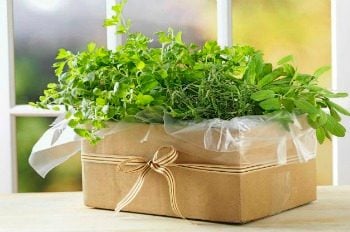
Cardboard Container Gardening
These days, the cost of container gardening can really add up. Save money and spend it on plants instead by using cardboard boxes as the containers. Treat them the way you’d treat conventional containers: Fill with soil, make sure you have proper drainage and don’t forget to water.
But will a cardboard container really hold up for an entire season through watering, wind, rain and everything else you and nature throw at it? Along with a few other gardeners around the country, we tested some out, and the answer is—yes!
Sure, this approach might not be for those who like everything neat and tidy, but if you’re adventurous, think inside the box here! Remember, with the right plants, by the end of summer you can’t see the container anyway. If you’d like, add a little reinforcement with tape in any weak areas. Or line the box with a plastic bag with drainage holes to keep it from getting soggy. And if looks are important to you, try some of our ideas for dressing it up (keep reading!).
Decorate Cardboard Containers
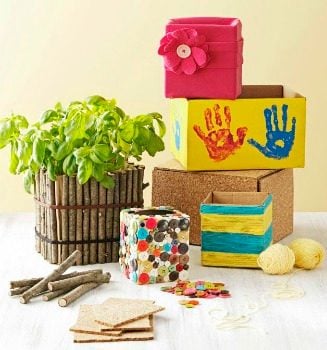
They say you can’t make a silk purse out of a sow’s ear. But you really can make plain old cardboard look good, and it doesn’t take much time, effort or money.
First the easy ideas: You can paint the box, wrap it in paper or cover it in old material. And if you’re up for being a bit more creative, try some of our other favorite materials: yarn, twine or rope.
My personal favorite is laminate or cork tiles. They’re available with amazing designs these days, and you can pick them up at a home improvement store for just a few bucks. You’ll probably need extra reinforcement for these, but they can really transform a cardboard box into a container worthy of the front porch.
Next, check out 5 easy ways to dress up your canning jars.
Use Cardboard as a Weed Barrier
Cardboard, newspaper and other compostable material is a quick and easy fix for weed problems. In just one growing season, you can reduce weeds by 75 percent or more.
Just place pieces of cardboard around the plants you want to protect. Water immediately to help the cardboard stay in place. (I say this because I’ve been that person chasing runaway cardboard caught by the wind.) You can add soil or mulch on top to reinforce it, too. The cardboard will suppress the weeds and eventually break down into the soil, adding useful organic matter.
Here’s 12 more ways to win the war on weeds.
Start New Flower Beds with Cardboard
The easiest way to start a brand-new garden bed is not with a tiller. Forget sweating behind heavy machinery, and use cardboard instead. That’s how I first discovered the magic.
This method will take a bit longer, but it really is the simplest way to start a bed. Just outline the shape you want on your grass (try using a garden hose to form the template), use edging to keep the grass out, then cover the area with cardboard. Water immediately and top with soil, mulch, leaves or anything you have on hand to hold the cardboard down.
After a few months, you’ll start to see the cardboard breaking down. Underneath, you’ll find fresh garden soil, ready for plants. The best time to do this is in fall, so the cardboard can break down over the winter and you’ll be ready to go in spring. The prep work probably won’t take much more than half an hour.
Another easy gardening tip: Fall leaves make great mulch for your lawn.
Build a Pathway with Cardboard
Creating a new garden path might seem like a lot of work, but you can have a simple one in about an hour. No, this isn’t a fancy-schmancy infomercial-type promise. All you need is cardboard, bricks or something else to outline the path, and mulch.
You’re going to be placing the cardboard directly onto the grass or whatever other surface you’re working on. Cardboard is thick enough so that you shouldn’t have any stray grass or weeds poking up through it. (If you do, just add more cardboard.) Place the cardboard in the shape you want the path to take. Outline with bricks, then cover with soil and mulch. Voilà!
Cardboard Seed Starters
The cost of seed-starting supplies can add up fast. Grow lights, special pots, fancy mats—I’ve tried them all. Cardboard boxes are the perfect solution for starting seeds because you can keep them growing inside longer, giving you stronger seedlings. (Don’t forget to provide them with plenty of light for optimum results.) Then just plop the whole thing, box and all, into your garden.
This approach is also perfect for kids. It’ll teach them to care for a garden—keep those seedlings thinned out, don’t forget to water, be patient—on a small scale before they move to a bigger space. Here’s how to host a seed-starting party.
Cardboard Windowsill Herb Planter
Isn’t the idea of herbs growing along your kitchen windowsill divine? I love the idea of snipping off a few bits of fresh basil or cilantro to throw into whatever’s cooking.
You can have your herbs cheaply, too, with cardboard. Line up small boxes in a window that gets good light—shoe boxes are one option—and fill with soil and herbs. You’ll be snipping and clipping in no time.
Check out the top 10 herbs to grow.
Shoe Box Garden
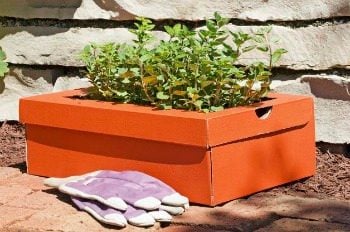
Finally, there’s a good use for all those shoe boxes you’ve been collecting for no reason! One of our photographers eagerly volunteered his wife’s shoe box collection for our tests.
Keep in mind that most shoe boxes aren’t very deep, so you’ll need to choose items that don’t need a lot of growing space. Lettuce, petite carrots and herbs are all good options.
For a cleaner appearance, we liked leaving the lids on our shoe boxes and just cutting a rectangle into the top. Then just add your soil and plants. You can put a shoebox garden in practically any corner of your yard or patio. It’s also a good project to do with kids, because it’s manageable. They can really take ownership of their small plots.
Here’s our guide to gardening tasks for kids of every age.
Cardboard Boxes in Square Foot Gardens
Square foot gardening keeps growing in popularity, and with good reason: You can grow more in less space. I use this method in my own backyard, and it works beautifully.
We’re giving the method a new spin with cardboard gardening. Use cardboard boxes to mark off your “squares” instead. Sure, most boxes aren’t perfect squares, but they don’t need to be. Add your boxes to a raised bed or an empty space in your yard. Follow the guidelines on how many plants to grow in each square foot; just reconfigure a bit if your boxes are bigger or smaller. Then you’re off.
Have kids try this method, too. My son and daughter love having their own spaces and planning what to put in each square.
Check out 10 fast-growing vegetables you can harvest quickly.

Picking out that perfect pair of birding binoculars can be both fun and overwhelming. With so many brands and models on the market, setting you back from a modest $100 to $2,500 and up, we can help you understand how to choose binoculars that are perfect for you.
The Birds & Blooms staff, along with frequent birding contributor Ken Keffer, conducted a binocular field test. We tried out pairs from different manufacturers, taping over the brand names to make it a fair test. If we learned one major lesson from our experiment, it’s that everyone is different. Nearly all of us had a different favorite for one reason or another, which you’ll see in our results. While we’re not necessarily crowning one pair the ultimate winner, we do think our picks will serve as a good birding binoculars buying guide. Ready to start shopping? The birds are waiting!
Next, check out 5 top-rated binoculars for every kind of birdwatcher.
Our Picks for the Best Birding Binoculars
Best Value Binoculars
Nikon Monarch M7 8×42
These stole the heart of executive editor Kirsten Schrader, and seriously impressed many other testers. They’re the perfect birding binoculars for those looking to go beyond the basics but not quite ready to break the bank. These are a great deal and will last you years with their sturdy modern design.
Best Binoculars for Beginners
Celestron NatureDX 8×42
If you’re just starting to go birding, we understand that you might not want to spend a lot of money on binoculars. If that strikes a chord, these are for you! Many of our testers rated them higher than more expensive brands. Lightweight and easy to focus, they’re the ideal starter binoculars.
Best First Impression
Carson TD-842 ED 8×42 3D Binocular
They say you don’t get a second chance to make a good first impression—and if that’s the case, these binoculars take top honors. These Carsons had a great look and feel. The view was nice, too, making them quite a hit with many of our testers.
Don’t forget about the best bird field guides for birders.
Best Binoculars for Backyard Birding
Kowa BD42-08XD
Do the rest of the choices on this list seem a little daunting? If you’re just looking to enjoy the birds in your own backyard, consider these Kowas. Small and compact, they’re ideal for keeping by your window for the moment you spot that bird you’ve been trying to attract for ages.
Best Midrange Binoculars
Vanguard Endeavor ED II 8420
If you’ve moved beyond the lowest-priced binoculars but aren’t ready to commit to a high-end pair, consider this choice. We liked the clarity of close-up images and the clear illumination of the subject. These will serve you well at the stage of your birding life when you’re not quite an expert but no longer a newbie. Psst—here’s 7 ways to be a better birder.
Best Splurge Binoculars
Leica Ultravid HD-Plus 8×42
If you’ve graduated to birding beyond the backyard, consider these Leicas. With a wide field of view, gorgeous clarity and impeccable lighting, they’ll allow you to spot almost any target you choose. Our testers said that just looking at and holding them made it obvious they were beautifully crafted. You won’t be sorry you splurged.
Check out the ultimate guide to backyard bird photography.
Best Binoculars for Birding On the Go
Zeiss Terra 8×42
Great lighting, ease of focus, fantastic clarity—these won lots of praise from our reviewers. While Zeiss is a brand typically known for binoculars running $1,000 and up, these deliver high quality at a reasonable price. No matter the terrain, they’re sturdy and ready for anything.
Best Binoculars for Serious Birders
Swarovski EL 10×42
Got some money burning a hole in your pocket? Consider these Swarovskis. The higher magnification allows for greater discernment of detail and makes them excellent for long-distance birding. Some testers thought they were heavy, but the quality justifies the extra weight and bucks.
Best Clarity and Field of View
Opticron Explorer Wide Angle 8×42
This wide-angle pair had the best field of view, but the clarity of the images and the ease of focus were impressive, too.
How to Choose Binoculars
- We strongly recommend testing out binoculars for yourself. Look for a birding festival in your area: Optics dealers often set up shop there, allowing you to test many brands and styles. Otherwise, call a birding or outdoors store near you to see if they have samples.
- Try out different brands and types of binoculars. Make sure they’re not heavy on your neck or too bulky for your hands.
- Many birdwatchers use an 8×42 model, a good all-around size. These numbers on binoculars mean an object appears 8 times closer and the objective lens diameter is 42 millimeters.
- The more you pay, the better and more durable the lens, but you don’t have to break the bank. Start with a waterproof model and work up from there.
- Binoculars should be easy to focus instantly and precisely.
- The field of view should be fairly wide, with no distorted edges.
- Whether you’re focusing close up or far away, you want a great picture. Try digiscoping to take better bird photos
- The image should be as bright as or brighter than what you can see with your naked eye, not darker.

How to Use Binoculars for Birding
Bins
This word is birder jargon for binoculars, which are one of the gifts any bird lover will absolutely adore.
Diopter Ring
Move the ring to adjust this side’s ocular lens. It allows for differences in your eyes and focuses your view correctly.
Hinge
The hinge connects to the two barrels. Hold the eyecups to your eyes and pivot the barrels until you see one circle-shaped image.
Eyecups
Here’s a tip. If you wear glasses, the eyecups should be twisted down. Sans spectacles? Twist up.
Ocular Lens
These lenses, closest to your eyes, magnify the object.
Focus Wheel
Spin the wheel to move the ocular lenses simultaneously and bring the bird into focus.
Objective Lens
These large lenses gather light. The bigger the lens, the more light it captures, which means a brighter image.
Barrels
The magic happens here! Each barrel works like a mini telescope to deliver a clear, crisp image.
Now that you know how to buy birding binoculars and know how to use them, check out birding gadgets and gear you never knew you needed.

If you like to save money, you’ll love the idea of rooting stem cuttings. And it’s pretty simple—find a straight species, an older cultivar or plant not under a patent, clip off a juvenile section of the plant’s stem, then coax roots to grow from it. Just think, you can clone as many examples of the mother plant as you wish for the cost of potting medium and a jar of rooting hormone.
“Because many plants root readily from cuttings, this is one of the most popular forms of plant propagation, especially for trees, shrubs and vines,” says Justin Hancock, horticulturist at Costa Farms. “Propagating with cuttings doesn’t usually interfere with the plants’ growth, and you don’t need to worry about pollinating a flower and waiting for the seeds to ripen—or digging up the plant to take root cuttings.”
Stem cuttings can be taken in spring, summer or fall, depending on the species. Pliable spring cuttings are called softwood cuttings. Semi-hardwood cuttings are a little more rigid and are gathered in late summer. Finally, hardwood cuttings are taken when plants are dormant in late fall or winter, stored for the cold months, then rooted the following spring. Check out the top 10 plants to grow from plant cuttings.
The benefits of rooting cuttings versus starting from seed? “It gives you an exact clone of the one you propagated from,” Justin says. “Seeds, because they’re a combination of the mother and father plants’ DNA, usually provide some variation.” Depending on the species, stem cuttings also give you a bigger plant, faster. You can also grow succulents from cuttings.
How to Root a Softwood Cutting
- Remove leaves from the bottom half of the stem. This reduces moisture loss while leaving some foliage for photosynthesis.
- Coat the base of the stem in rooting hormone to help stimulate root growth and reduce rot.
- Insert the bottom inch of stem with the rooting hormone into a premoistened mix of half peat moss and half vermiculite. Firmly tamp soil around the stem.
- Mist stem and leaves with a spray of water, then loosely place a clear plastic bag over the plant to increase humidity.
- Place the covered plant 6 inches below a fluorescent light. Remove the plastic cover and transplant when roots are coming out of drainage holes or pressing against the sides of the container.
Plants to Propagate by Cuttings
- Abelia
- Beauty bush (Kolkwitzia)
- Bittersweet (Celastrus)
- Cassiope
- Chaste tree (Vitex)
- Chocolate vine (Akebia)
- Cotoneaster
- Crape myrtle (Lagerstroemia)
- Deutzia
- Flowering quince (Chaenomeles)
- Fothergilla
- Heavenly bamboo (Nandina)
- Lantana
- Lavender
- Madagascar dragon tree (Dracaena marginata)
- Serviceberry (Amelanchier)
- Smokebush (Cotinus)
- St. John’s wort (Hypericum)
- Summersweet (Clethra)
- Plumbago
- Virginia sweetspire (Itea)
- Witch hazel (Hamamelis)

